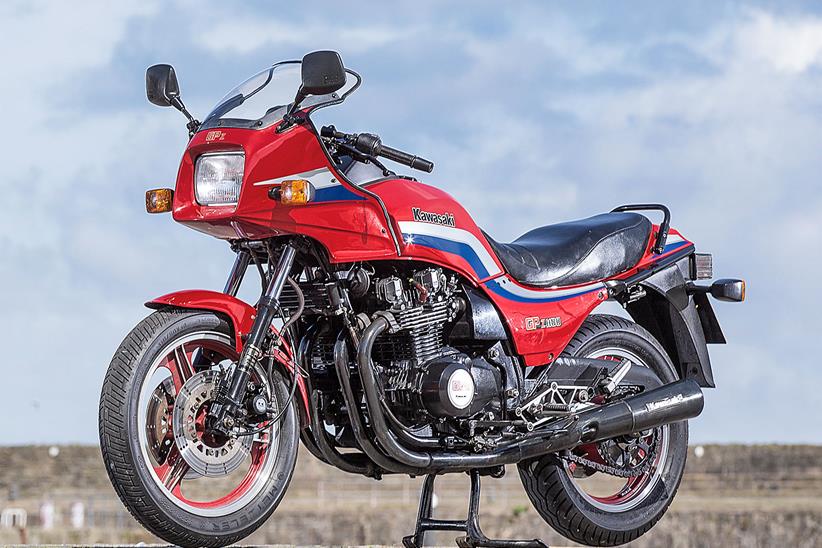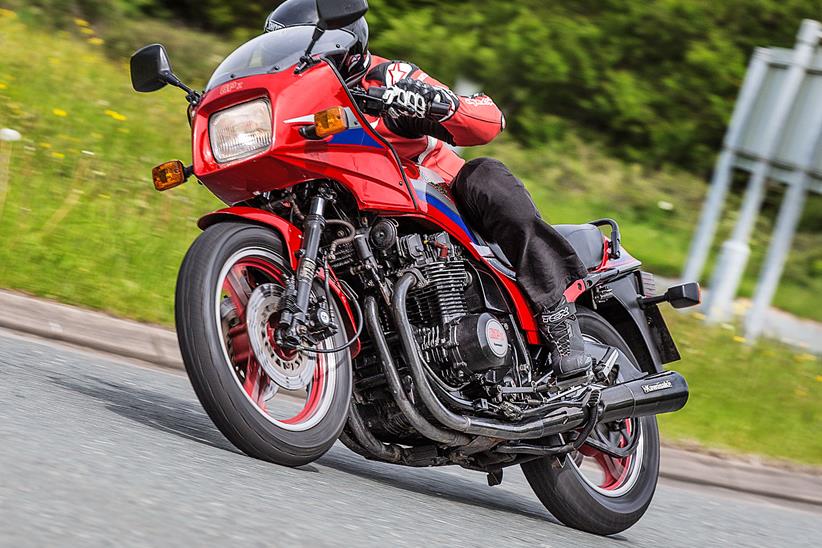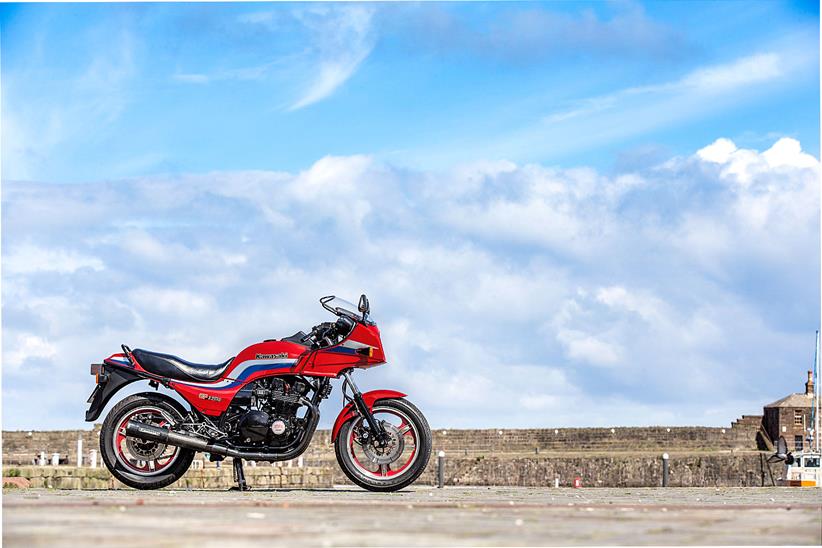Kawasaki GPz1100: The last king of a vanished clan – aircooled superbikes
Kawasaki’s meanest Zeds haven’t always been green – the GPx1100 was slathered in bodywork painted red by the blood of its inferior rivals.
![]() or a fairly brief, incandescent, riotous period in the early to mid-1980s, the ultimate incarnation of Kawa’s air-cooled fours became the GPzs. The new 550, 750 and 1100 (we’ll gloss over the 305 for now) were a macho family of sportsters first introduced in 1981 which ruled the performance roost in pretty much every category until the new generation of liquid-cooled, alloy-framed machines stole their thunder. They were slathered in blood-red livery with black and silver racing stripes, their engines black as coal. The respect they garnered from motorcyclists was total.
or a fairly brief, incandescent, riotous period in the early to mid-1980s, the ultimate incarnation of Kawa’s air-cooled fours became the GPzs. The new 550, 750 and 1100 (we’ll gloss over the 305 for now) were a macho family of sportsters first introduced in 1981 which ruled the performance roost in pretty much every category until the new generation of liquid-cooled, alloy-framed machines stole their thunder. They were slathered in blood-red livery with black and silver racing stripes, their engines black as coal. The respect they garnered from motorcyclists was total.
In simple terms, that original air-cooled GPz family lived through two generations: the first, twin-shock GPz550H1 and GPz1100B1 from 1981, joined by the GPz750R1 in 1982. Then the second generation, restyled, ‘Uni-trak’ monoshock versions of all three from 1983 through to ’85. And though all were undoubtedly class-leaders on both road and track, it was the big 1100 that was always ‘The Daddy’.
As such the final GPz1100A was, and remains, some kind of ultimate. It was top dog at the end of the era of air-cooled superbikes. In 1984 Kawasaki’s own, revolutionary, six-years-in-development GPZ900R arrived, casting the 16-valve/liquid-cooled die for all superbikes to come and instantly making the air-cooled GPzs obsolete. As such, the GPz1100A was the ultimate incarnation of the breed and the fastest and most revered of its type. It had pure-bred heritage by the bucketload, racing DNA, truly pioneering technology and brazenly glamourous good looks – and if that little lot doesn’t add up to a ‘modern classic’ then we don’t know what does.
The GPz1100A has also – a little surprisingly – yet to achieve the revered status and collectability that its bloodline suggests it deserves. Sure it’s not perfect: its looks are a little Marmite, its finish and fuel injection in particular a little brittle. But although prices are now slowly on the rise, the last, true GPz11 remains something of a bargain, at least compared to Katanas, with decent examples still to be had for around £2500. Catch ’em while you can…
![]() For ‘some kind of ultimate’ (which the GPz1100A surely is), it’s a little humbling to realise that its creation was more as something of a stop-gap until the arrival of Kawasaki’s true, new tour-de-force: the ultimately six-years-in-the-making, wholly revolutionary and class-redefining GPZ900R, which finally went on sale in 1984.
For ‘some kind of ultimate’ (which the GPz1100A surely is), it’s a little humbling to realise that its creation was more as something of a stop-gap until the arrival of Kawasaki’s true, new tour-de-force: the ultimately six-years-in-the-making, wholly revolutionary and class-redefining GPZ900R, which finally went on sale in 1984.
You have to remember that by the end of the ’70s, Kawasaki’s two-valve Z1000 was fairly old hat. At the same time, Suzuki’s new four-valve GSX1100E, introduced in 1980, had snatched the boss superbike crown. In short, at the start of the new decade Kawasaki needed a new performance flagship – and it needed it fast. The GPzs, not just one bike but a whole new family of performance machines designed to be the ultimate evolution of the existing Zeds, were the end result.
Inspired by both its American AMA superbike racers and its success with the 250/350 tandem twins (Kawasaki had dominated 250 and 350 Grands Prix from 1978-’82, hence the adoption of the GP moniker), the new family was launched in 1981 with the first GPz1100B1 (or Z1100GP as it was referred to internally at Kawasaki), along with the GPz550D1.
Although fairly conventional in its twin-shock, unfaired layout, Kawasaki’s new, Z1000H-based flagship caused a tsunami at the time for its combination of fearsome power, mean all-black powertrain and racy, red livery.
But despite those imposing looks (and Kawasaki’s own spiel), the GPz was actually a triumph of evolution rather than revolution – an evolution that continued through to the final GPz1100A3 in 1985. The revolution would have to wait until the GPZ900R.
Maximised performance
The engine exemplified this perfectly, being a high performance evolution of that found in the Z1000H, Kawasaki’s first fuel-injected roadster introduced 12 months earlier. To maximise performance, Kawasaki’s engineers used pretty much every trick they’d learnt through the company’s AMA racing experience. Although the H’s 66mm stroke was retained, bores were increased to 72.5mm to give a 1089cc capacity, new, bigger pistons had reshaped crowns to increase compression, valves were enlarged to increase fuel flow, cams were reshaped to provide more lift but less duration, the roller-bearing crankshaft was lightened, and both the clutch and five-speed gearbox were strengthened to handle the increased power.
How much power? The B1’s 108bhp at 8500rpm was enough to make the new GPz1100 the most powerful four of 1981, beating the GSX’s 100. Mission accomplished? Yes, but only briefly. Imperfections and intense competition meant that the GPz’s evolution had to continue.
Criticism of the original fuel injection system, itself little different to the car-style system of the Z1000H and made in Japan under license from Bosch, led to an uprated, now digital fuel injection (hence ‘DFI’) system for 1982’s succeeding GPz1100B2. Additional criticism of the black finished exhaust (which suffered particularly in damp Britain) led to it being replaced by black chrome. Finally, to enhance the 1100’s resemblance to the rest of the GPz family (which by now included a 750 version), the B2 also gained a small headlamp fairing.
But the biggest evolution of all came with the GPz1100’s final incarnation – 1983’s GPz1100A ‘Uni-trak’.
This time around there were major technical changes to the whole GPz family, most notably the introduction of Uni-trak monoshock rear suspension (as first successfully introduced on the previous year’s GPz550H1), plus a new, larger, now frame-mounted fairing. Kawasaki also took the opportunity to introduce brand new, fairly radical, swoopy styling across all three bikes, along with a new clock layout which featured twin dials inside the cockpit, but with an additional warning light cluster mounted on top of the fuel tank. The new A1 also gained a further power boost by using revised camshafts (including, for the first time on a big Kawasaki, the valve shims now under the buckets). This raised peak power to a class-leading 120bhp.
Sadly, as with many ‘ultimates’, it couldn’t possibly last. At the end of that same year Kawasaki itself finally revealed the future of superbikes by unveiling its truly sea-changing, liquid-cooled GPZ900R at the Cologne Show, a bike which not only made the same power as rival manufacturers’ 1100cc superbike engines but also made Kawasaki’s own GPz11 look decidely sluggish and overweight.
The two remained on sale side-by-side through 1984 but with the 900 massively out-selling the 11, the writing was on the wall. At the end of 1985 the 1100, ‘the ultimate evolution of the air-cooled Zed’, was withdrawn from sale.
Timeline
|
Frame number: KZT10A-000001> Engine number: KZT10BE-019301> Colours: Firecracker Red or Polar White Introduced alongside similarly styled versions of GPz family, including cute 550, handsome 750 and oddball 305. Apart from 305, recipe identical: evolved, black-painted, two-valve fours, pioneering monoshock chassis (not yet on the 1100) and mean, blood red paint. ‘Who can catch a Kawasaki?’ Quite. |
|
|
Frame number: KZT10A-010801> Engine number: KZT10BE-029301> Colours: Firecracker Red or Galaxy Silver A few small updates to the exhaust system and an inner fairing panel to tidy up the exposed framework and wiring around the clocks and headlamp, plus a new, silver colour option. |
|
|
Frame number: KZT10A-015901> Engine number: KZT10BE-037201> Colours: Firecracker Red or Galaxy Silver Quickly proving to be overshadowed by the new, smaller, lighter and more powerful GPZ900R, this was to be the last model for the GPz1100 – although the name was actually resurrected briefly for a ZZ-R1100-derived |
What to look for
Originality
Good and fairly original GPz11As are now thin on the ground. This is because the A1 was only briefly popular and quickly rendered obsolete, causing values to plummet and bikes to be butchered or stripped. Only recently has it gained ‘classic’ status. As a result engines were stripped to be retro-fitted to earlier Zeds, many examples were converted into ‘streetfighters’ while even survivors often have chopped rear mudguards, twin-beam conversions, big-bore tunes and more which, due to the scarcity of original parts (uncut rear mudguards and bodywork are virtually unobtainable), massively affects values.
Fuel injection
Even in second generation DFI spec, Kawasaki’s first stab at fuel injection wasn’t a great success and caused masses of set-up and servicing problems, not to mention recalls. In fact, the problems were so big that Kawasaki wisely reverted to CV carbs for the GPZ900R. As a result many surviving GPz11s have been converted to carbs, which can improve performance but affects value.
![]()
Top end / valves
A missed gear over-rev (see Crankshaft, right) usually results in a bent valve or three, identified by an audible clicking noise. A major bend could also end up breaking the valve guides. Expensive.
Cosmetics
The black painted exhausts of the original B1 GPz1100 suffered in British winter and although this was improved by switching to black chrome from the B2, the finish throughout the 1100 right up to the last A3 model wasn’t brilliant. Thirty years on, expect the red paint and characteristic stripes to have faded and most of the black to have gone off. On the other hand, good examples have almost certainly had a restorative respray by now. If you’re a stickler for originality then check it’s been done to the correct scheme – many haven’t.
Crankshaft
A pressed crank is one of the GPz’s few potential faults, with early hard-ridden examples sometimes suffering from a twisted crank if the engine was over-revved – often due to a missed gear. Repair requires removal, straightening and welding to prevent a repeat. Once this repair/modification is performed the air-cooled, 8v Kawasaki bottom-end is as bulletproof as any.
Frame
Large diameter but thin-wall tubular frame was occasionally exposed by a weakness at the side-stand bracket, not only resulting in some bikes veering into the kerb but in some cases with a wrecked frame – more than a few were replaced under warranty while others were repaired and repainted.
Seized headraces
The lower taper roller bearing on the headstock is also prone to seizure due to a lack of grease – a problem prevalent on a variety of Kawasaki models during this era. A relatively easy fix but potentially dangerous if ignored. Check for free movement.
Exhaust
Partly due to the not particularly brilliant finish but also because of its age, few bikes around today still retain the original black 4:2 exhausts. A common replacement in the UK was Motad’s Neta 4:1, though more desirable are Vance & Hines or Harris versions.
![]()
Brakes
Due to both the GPz11’s performance and weight, as well as the new semi-metal pads, the (reasonably small) front brake discs have a pretty hard time of things. The result of this is either warping or excessive wear. The calipers themselves are actually reasonably basic and, as was typical of the period, will seize up if they are not properly maintained.
Wheels/tyres
Newly designed three/six- spoke alloy wheels were thankfully much stronger than the preceding seven-spokers. A popular choice of tyre to go for is the Bridgstone BT45.
Gearbox
Owners of some early examples back in the 1980s complained of poor gear selection and, particularly, of a tendancy for it to jump out of second gear. Usually the offending gears and mechanism were replaced by modified items under warranty.
Values
Mint £4000-£5300
Clean £2700-£3500
Tatty £1300-£2500
Hound £950-£1200
Spares prices
(All from Z-Power except where marked)
Tail light lens £15
Oil filter, genuine £5.75
Air filter (from Wemoto) £10.49
Spark plugs per set £10
Front brake mastercylinder repair kit
(from Wemoto) £38.12
Clutch plate kit (EBC, from Wemoto) £58.03
Front disc £110
Alternator cover emblem, genuine £39
Shock absorber (Hagon) £299.50
Head bearing set (from Wemoto) £37.50
Chrome mirrors, pair, aftermarket £28
Regulator/rectifier £85
Indicator, pattern £17.85
Throttle cable £25






